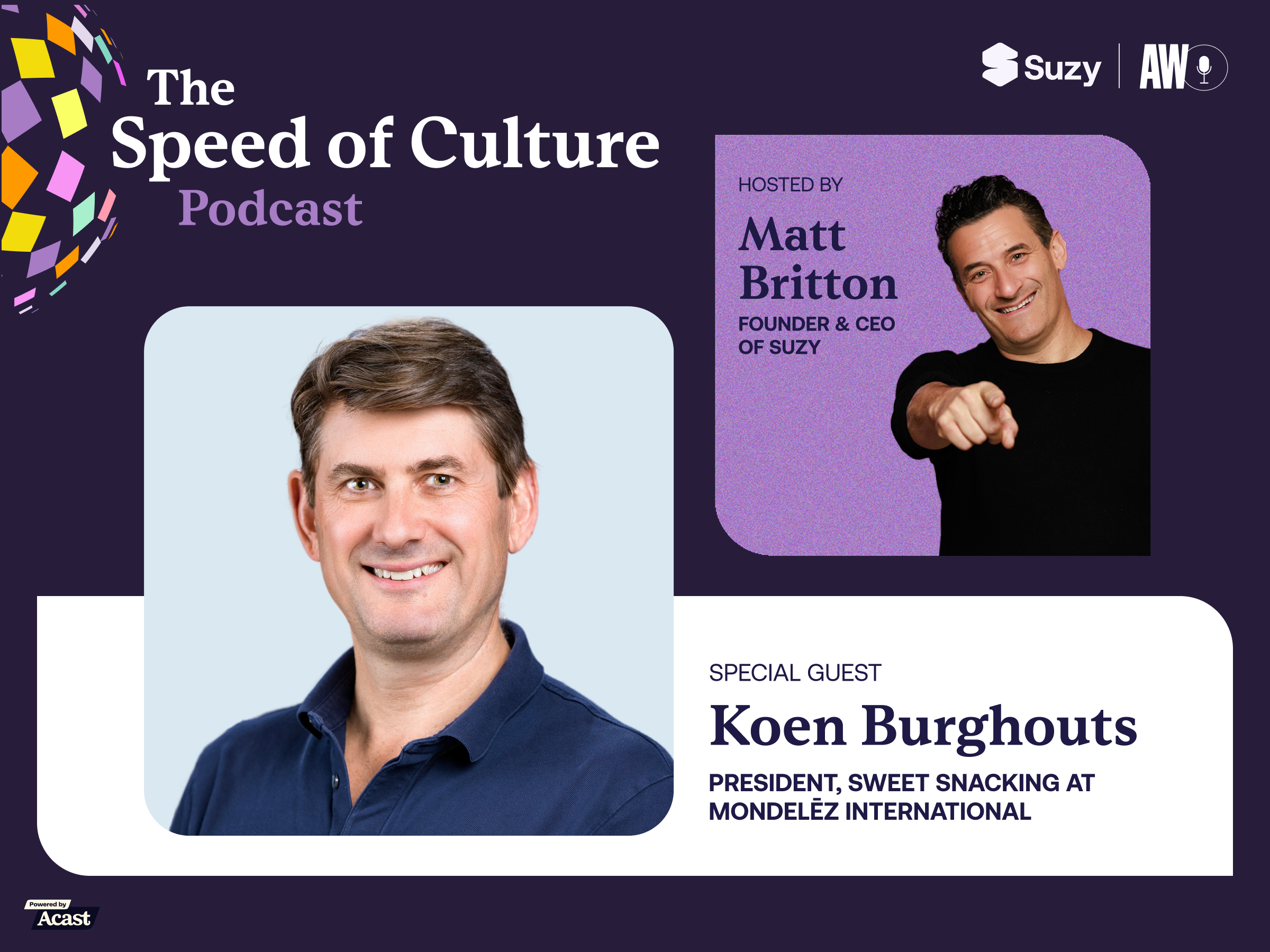Before you start using Suzy’s powerful consumer research platform to connect directly to your target audience, you need to answer the two most important questions that market researchers ask themselves:
What do you want to learn, and how will you gather the information needed?
Suzy can help you with data collection, of course, but you still need to consider which types of market research methods will be most useful to inform your unique goals.
Market research can be categorized according to the data collection method used and the type of information being collected. Read on to find out more about what questions each market research method can answer for you.
What Can You Learn Through Market Research?
Market research methods help you to learn about current or potential customers and their needs. This helps you understand how they may relate to your existing or future product or service. You can treat market research like a large fishing net, reaching far and wide and gathering up all the information you possibly can. You can also zoom in on a specific area with a magnifying glass through screener questions and retargeting actions—getting very specific and probing. Where you look for information and the information you aim to gather will determine the type of method you should use.
Market Segmentation
Not every customer in your market is the same, but they probably share some patterns, preferences, or characteristics. Identifying these segments allows you to deliver individualized experiences, personalized marketing, and improved products or services. Understanding your market segments better allows you to forecast how new products or services might perform in each segment.
Many market researchers collect as much data as possible about your current customers through a variety of methods, including surveys, website analytics, database research, and focus groups. These researchers try to identify patterns of preferences among your customers. Ideally, their preferences fall into distinct clusters based on identifiable characteristics. Researchers will then use these combinations of customer characteristics, known as segmentation bases, to define market segments.
There are a few main types of segmentation bases:
- Descriptive: Descriptive bases are most commonly used because they are the easiest to measure. This type includes geographical information, such as the specific U.S. state a customer lives in. Another type of descriptive segmentation basis is demographic information. This includes age, education, income, occupation, and gender. (By the way, Suzy’s platform uses a variety of these different descriptive bases to filter our consumer panel and help you find the exact target audience you’re looking to reach!)
- Behavioral: Though generally more difficult to measure, behavioral bases are more influential determinants of consumer purchases. Behavioral characteristics commonly used in segmentation include brand affinity, consumption and shopping habits, and spending patterns. (You can also create these kinds of bases on Suzy through the use of screener questions that allow our panelists to self-evaluate their behaviors)
- Benefits: You can segment your market based on the benefits that consumers are looking for when they buy a certain product. You can then supply a product or service that provides those benefits.
- Psychographic: Segmenting a market by customers’ shared personality traits, beliefs, values, attitudes, interests, and lifestyles is known as psychographic segmentation. While these characteristics are generally not observable - consider one’s attitude towards organic, clean foods, for example - they are extraordinarily powerful as a segmentation base.
Once you’ve established what kind of market segment you’re looking to target, you can use Suzy to isolate this audience with specific demographic targeting parameters, as well as multiple-choice screener questions to filter out consumers by behavior.
Competitive Analysis

Competitive analysis involves identifying your competitors and then evaluating their business structure, offerings, and strategies. Using Suzy, for example, you might speak with the consumers in your competitors’ audiences to understand why they purchase certain products. Your analysis aims to determine your competitors' strengths and weaknesses relative to your own target markets.
For each competitor, test the following:
- Product or service
- Product or service's profitability
- Marketing assumptions
- Current and past marketing strategies
Product Development
Market research for product development purposes minimizes the risk of failure for a new product or app entering the market. Market research is particularly useful in four stages of product or app development:
- Conception: Market research can find opportunities for something new and provide insights into customer challenges and gaps your company might fill.
- Formation: Market research can help turn an idea into a concept that you can test, testing packaging, advertising, and pricing.
- Introduction: Use market research to evaluate customer opinions once the product is in the market, adapting your messaging or targeting a different segment.
- Improvement: Research can help identify areas of improvement to your product or app. Research also can find opportunities to introduce your product to different markets.
If you’re getting into product development research, you can use Suzy to connect with consumers about their opinions on product concepts, learn more about customers' pain points, to see how people interact with an app or website.
Campaign Effectiveness
Once you’re finishing up a marketing campaign, you’ll want to know whether your efforts were successful or not and how to make them better. Market research helps you gauge the success of a marketing campaign through data about the end results and engagement levels.
End results of campaigns are mainly measured by web traffic and sales figures but you should be able to measure how much of an increase in revenue or site traffic you can directly relate to the ad campaigns you run.

Failure of a customer to make a purchase immediately does not mean your campaign was not successful. Campaigns can increase the level of engagement, which is how much someone interacts with your campaign or company. Customer engagement indicates interest and increased likelihood of future purchases. Some engagement measurements include shares, likes, and comments on social media or the number of opens, clicks, and unsubscribes to email newsletters, for example. You can also reach out to consumers directly to ask them about actions they might have taken that would not be tracked – for example, if they told friends about your product or sought it out in a physical store.
Brand Awareness and Reach
Your brand is made up of images and characteristics that people associate with your company. By speaking directly to consumers to learn what they think the assets they associate with your brand, you can manage your brand’s identity at every lifecycle stage, from brand creation to new product launches to re-branding.
While there are several types of brand research, these are the most common:
- Brand awareness: Does your target market know your brand?
- Brand loyalty: Are you retaining customers, and how loyal are they to your brand?
- Brand advocacy: Are your customers willing to recommend your brand?
- Brand value: How much are customers willing to pay for a product or experience associated with your brand?
- Brand positioning: How can your company's differentiating qualities be positioned apart from others in the customer's mind?
Speaking directly with consumers on platforms like Suzy can be an excellent way to identify the features that differentiate you from your competitors. You can use surveys to learn about customers' emotions and associations with certain brands, and then translate these opinions into emotionally compelling consumer language.
What Methods Are Used for Market Research?
Primary vs. Secondary Research
You can divide all research into one of two categories based on the source of the information: primary or secondary research.

Primary research gathers information for your specific purposes, in which you collect data through methods of your own design. Suzy’s insights tool is considered a form of primary research, because you are using our platform to ask questions directly to consumers.
Secondary research draws on information that already has been gathered by another source or during another time.
Secondary resources commonly include:
- Industry trends
- Forecasts
- Market estimates
- Technical analyses
- Statistical tables
- Prior internal studies or reports
By analyzing secondary data, you can identify competitors, establish and compare benchmarks, and begin to identify target segments.
Examples of secondary research include the following:
- Competitor benchmarks are among the most widely used secondary research methods. They measure key performance indicators and provide a comparison to businesses within the same industry and of a similar size. Benchmarks are useful for understanding your company's revenue, operating expenses, sales and profit margin.
- Sales data helps segment customer trends, and internal sales data highlights where to focus marketing efforts. Competitive sales data helps make sure that you're capturing the full potential of the market.
Secondary sources include the following:
- Public: Governmental agencies, chambers of commerce, unions, and professional associations provide ample secondary market research. For example, the U.S. Department of Commerce's Bureau of Economic Analysis publishes various national economic indicators. For another example, the U.S. Census publishes an annual State and Metropolitan Area Data Book that provides statistics for metropolitan areas, cities, and counties.
- Educational: Post-secondary institutions of higher education often conduct more research than any business could. College and university business and marketing departments publish journals, graduate student projects, theses, and faculty-based projects. Visit departmental websites or contact the college library for information about available research topics.
- Commercial: Trade associations, publicly traded corporations, financial institutions, and Dun and Bradstreet are typical commercial sources of market research. For example, IBISWorld publishes detailed reports on more than 1,300 industries across several countries. Trade publications often feature in-depth product, industry, and competitor data for specific industries.
Qualitative vs. Quantitative
Research is either quantitative or qualitative.
- Quantitative market research involves data that you easily can count or tabulate. You can include significant numbers of respondents. Most consider this to be objective information.
- Qualitative market research gathers information about people's ideas, motivations, and emotions. This research is more in-depth and limited to smaller sample sizes. Most consider this to be subjective information. Qualitative research’s purpose is not to measure, as in quantitative research, but to create a deeper understanding of your customers by exploring topics in more detail
Sometimes combining the two can provide an even greater insight into consumers' choices, providing a better understanding of the context of the data. For example, you can use quantitative research like Suzy’s multiple-choice question tools to gain behavioral data, and follow with qualitative research, such as Suzy’s open-ended questions, to learn about the reasons behind those behaviors.
.webp)
.avif)






